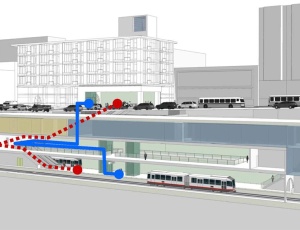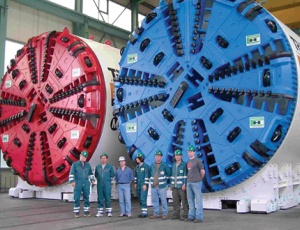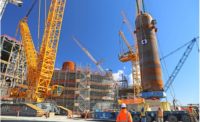Mayor Gavin Newsom joined the San Francisco Municipal Transportation Agency and numerous elected and community leaders to ceremoniously break ground on the Central Subway project, which is Phase 2 of the Third Street Light Rail project.


When service begins in 2018, this 1.7-mi extension of the existing T Third light rail line will connect communities from Visitacion Valley to Chinatown.
�The Central Subway represents a dramatic investment in San Francisco�s transportation future,� says Mayor Newsom. �Tens of thousands of residents and visitors will use this environmentally-friendly subway to get to work, school and to see their families and friends.�
In January, construction began with work to relocate utilities that currently reside within the footprint of the future Moscone Station and the portal under the I-80 freeway where a tunnel boring machine will go underground. The $9.3-million utilities relocation work is being performed by the San Francisco firm Synergy Project Management, Inc., with completion expected by the end of this year.
�It is incredibly gratifying to see construction begin on the Central Subway,� says SFMTA Executive Director/CEO Nathaniel P. Ford Sr. �We appreciate the tremendous amount of support from federal, state and local officials and the incredible efforts of so many community partners who are helping to make this project a reality.�
Earlier this month, the project received a positive review as part of the Federal Transit Administration�s New Starts program with a Medium-High project justification rating and Medium-High overall rating. In addition, the president�s FY2011 U.S. Department of Transportation budget for the first time included a specific funding recommendation�$20 million to support ongoing design work for the project. Three final design contracts for the project are either awarded or in the final stages of negotiation.
According to Judson True, spokesman for the SFMA, the first design package has been awarded to Parsons Brinckerhoff and Telamon (a joint venture) for architectural and engineering services. This contract is for $5.7 million.
The second design package was awarded to PB, Michael Willis Architects, Inc. and Kwan Henmi Architects and Planners (a joint venture) for $39 million with final approval from the Board of Supervisors pending.
The third design package is under consideration for award with the SFMTA board (next board meeting) to HNTB Corp. and B&C Transit, Inc. (a joint venture) for $32 million.
The Central Subway has received $72 million in New Starts federal funding to date. Environmental clearance of the project was granted by the FTA in November 2008, while approval to begin final design was granted in January. The total project cost (with contingency) is expected to be $1.57 billion, with the federal government contributing close to $1 billion.
�After the hard work over several decades, today�s milestone brings us one significant step closer to seeing the Central Subway built, and will help us realize our vision of a 21st century Transit First city,� says Board of Supervisors President David Chiu. �The grassroots support for this project reflects the significant benefits it will provide to communities throughout San Francisco.�
Recent estimates indicate that the Central Subway will support between 37,000 and 43,000 jobs over the life of the project.
The Central Subway will extend light rail service with a surface stop on 4th Street near Brannan Street and subway service under the South of Market, Union Square and Chinatown neighborhoods. It will operate as an extension of the T Third light rail line, which opened for full revenue service in April 2007.
The second phase of the Third Street Light Rail Project will extend service north from King Street along Fourth Street entering a tunnel north of Harrison Street, crossing beneath Market Street, and running under Stockton Street to Stockton and Clay Streets.A surface station will be provided near Bryant Street, and underground stations will be located at Moscone Center, Union Square and near Clay Street in Chinatown.
According to the MTA, this alignment represents slight modifications to the locally preferred alternative adopted by the Board of Supervisors in June 2005, in that the subway portal was shifted two blocks north and the surface station was added. The changes were the result of recommendations arising from cost reduction workshops conducted in late 2005. Other changes resulting from the workshops include shifting the Union Square station south, closer to Market St., to facilitate a connection to the existing Powell St. station, utilizing two tunnel boring machines instead of one to reduce the construction duration by two years, and building shorter stations.
A construction approach called �deep tunneling� will be used to construct the Central Subway. Deep tunneling allows most of the work to be done below ground, reducing disruption on the surface. The tunneling will be accomplished with a tunnel boring machine, a technology that has been used extensively throughout the world. Deep tunneling has great potential for controlling project costs by minimizing surface construction staging, reducing utility relocations and shortening construction time.
The only visible tunneling activity will occur at the portal construction location (4th Street between Bryant and Harrison streets) and at the excavation site (Columbus Ave. at Union St.).


Post a comment to this article
Report Abusive Comment